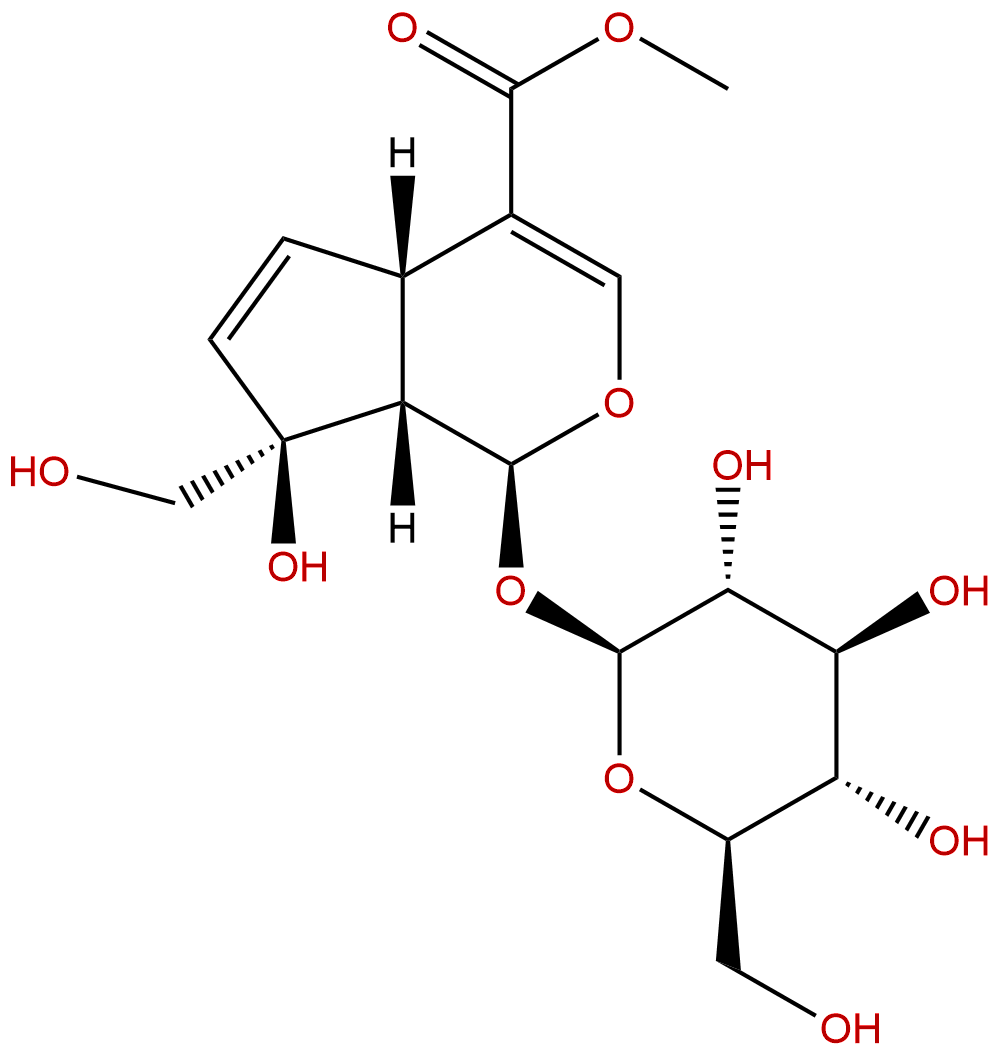
GardenosideCAS No.:24512-62-7
|
||||||||||
 |
|
|
||||||||

| Catalogue No.: | BP0625 |
| Formula: | C17H24O11 |
| Mol Weight: | 404.368 |
Product name: Gardenoside
Synonym name:
Catalogue No.: BP0625
Cas No.: 24512-62-7
Formula: C17H24O11
Mol Weight: 404.368
Botanical Source: Gardenia jasminoides Ellis
Physical Description:
Type of Compound: Iridoids
Purity: 95%~99%
Analysis Method: HPLC-DAD or/and HPLC-ELSD
Identification Method: Mass, NMR
Packing: Brown vial or HDPE plastic bottle
Storage: Store in a well closed container, protected from air and light. Put into refrigerate or freeze for long term storage.
Whenever possible, you should prepare and use solutions on the same day. However, if you need to make up stock solutions in advance, we recommend that you store the solution as aliquots in tightly sealed vials at -20℃. Generally, these will be useable for up to two weeks.
The product could be supplied from milligrams to grams
Inquire for bulk scale.
Description:
Gardenoside has hepatoprotective, pain‑relieving, and anti-mastitis effects. it may be a potential therapeutic herb against NASH by suppressed supernatant inflammatory cytokine production and intracellular NFkB activity. Gardenoside may be considered potential drug candidates that target P2X3 and P2X7 purine receptors.
References:
Chinese Journal of Information on Tcm, 2004, 11(6):500-502.
Effect of Concha Margatitifera Usta, Cholic Acid, Gardenoside, Baicalin on MCP-1 in the Ischemic Cerebral Tissue of Rats after Middle Cerebral Artery Occlusion.
To study the effect of Concha Margatitifera Usta, Cholic Acid, Gardenoside, Baicalin on the protein levels of monocyte chemoattractant protein (MCP-1) in the ischemic cerebral tissue of rats after middle cerebral artery occlusion in rats.
METHODS AND RESULTS:
The 110 male SD rats were randomly assigned to the normal group, middle cerebral artery occlusion for 12 hours group and Concha Margatitifera Usta, Cholic Acid, Gardenoside, Baicalin cure middle cerebral artery occlusion for 12 hours group, middle cerebral artery occlusion for 24 hours group and Concha Margatitifera Usta, Cholic Acid, Gardenoside, Baicalin cure middle cerebral artery occlusion for 24 hours group. The protein levels of MCP-1 were measured by enzyme linked immunosorbent assay (ELISA). The protein level of MCP-1 of the ischemic cerebral tissue of rats in the middle cerebral artery occlusion for 12 hours group was markedly increased than the normal group (P0.05). The protein level of MCP-1 of the ischemic cerebral tissue of rats in Concha Margatitifera Usta and Gardenoside cure middle cerebral artery occlusion for 12 hours group were significantly lower than it in the middle cerebral artery occlusion for 12 hours group (P0.01). There was no significant change on the protein level of MCP-1 in the ischemic cerebral tissue of rats between Cholic Acid, Baicalin cure middle cerebral artery occlusion for 12 hours group and the middle cerebral artery occlusion for 12 hours group. The protein level of MCP-1 of the ischemic cerebral tissue of rats in the middle cerebral artery occlusion for 24 hours group was markedly increased than the normal group (P0.05). The protein level of MCP-1 of the ischemic cerebral tissue of rats in the Concha Margatitifera Usta, Cholic Acid, Gardenoside ,Baicalin cure middle cerebral artery occlusion for 24 hours group were significantly lower than it in the middle cerebral artery occlusion for 24 hours group (P0.05 or P0.01).
CONCLUSIONS:
Reducing the level of MCP-1 of the ischemic cerebral tissue of rats after ischemia may be one of the most important ways for the neuroprotective effects the middle cerebral artery occlusion group.
Chinese Veterinary Science, 2013, 43(8):876-880.
Inhibited effects of gardenoside on the LPS-induced mice mastitis
METHODS AND RESULTS:
To investigate the protective effects of Gardenoside on the mice against mastitis,48 male and female mice were paired and randomly divided into 6 groups.Mouse mastitis models were established by pouring LPS into mammary gland after farrowing.Female mice with mastitis were treated with different concentrations of Gardenoside(25,50 and 100 mg/kg) and dexamethasone,respectively. Mammary glands of the mice were collected at 24 h after the treatment to study the effects of Gardenoside on the histopathology and the expression of myeloperoxidase(MPO),TNF-α,IL-6 and IL-1β. In result,the expression levels of TNF-α,IL-6 and IL-1β were significantly higher in the LPS group than the normal group,indicating the model of mastitis was established successfully in this study.Mammary gland pathological damages were significantly inhibited by Gardenoside treatment compared with the LPS group(P0.01).MPO expression levels were decreased with the treatment of low,medium and high doses of Gardenoside,and the expression levels of TNF-α,IL-6 and IL-1β were significantly lower in the Gardenoside group than the dexamethasone group.
CONCLUSIONS:
These results indicated that Gardenoside has inhibitory effect on mice mastitis,and the inhibitory effect exhibits a dose-dependent manner.
HPLC of Gardenoside
